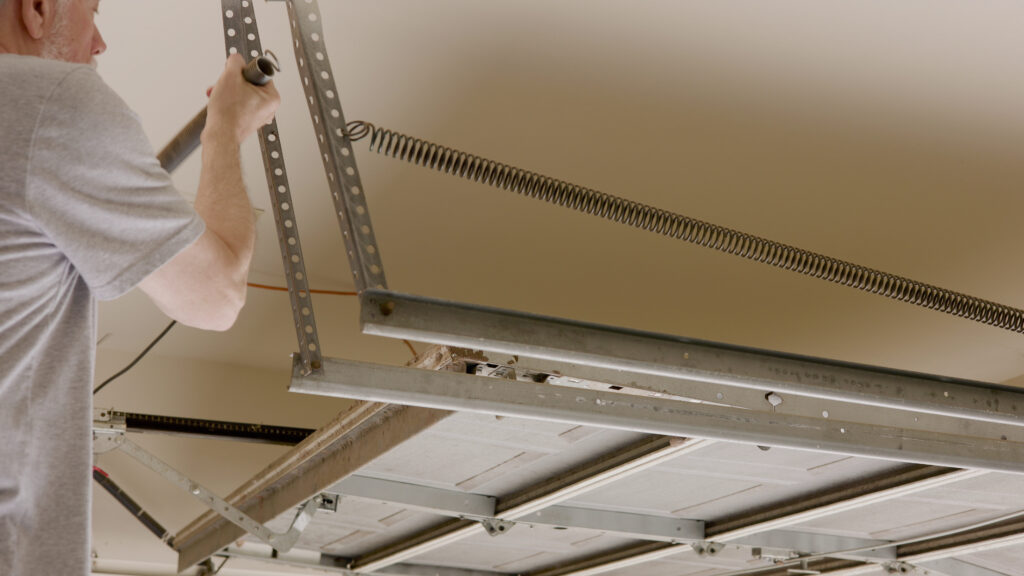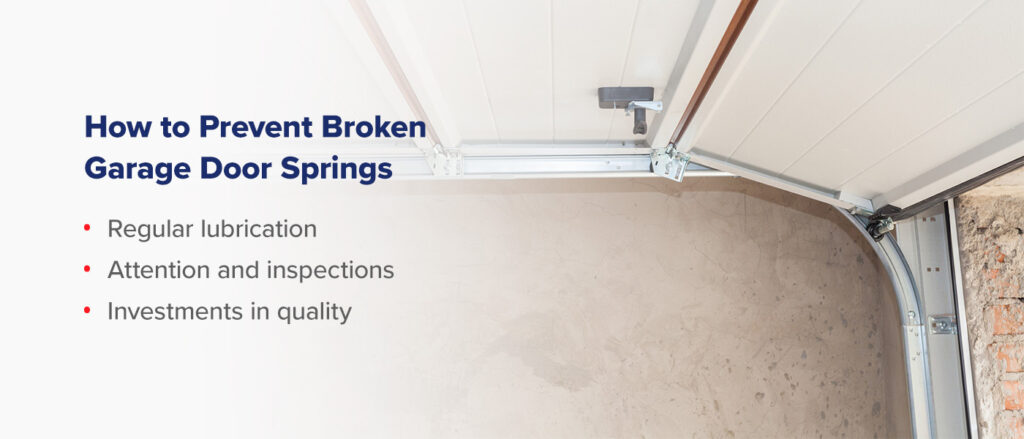
As you may be aware, a broken spring can be one of the reasons your garage door may not be working correctly. However, you may be unsure how to tell if a garage door spring is broken or what to do if it breaks. Here’s what you need to know about your garage door springs, how to identify what a broken garage door spring looks like, and what to do about them if they break.
Types of Garage Door Springs and How They Break
Your garage door has one of three types of springs:
- Most residential garage doors have one or two torsion springs, which you will find above your garage door when closed.
- Some garage doors — usually those with limited overhead space — have two extension springs on either side of the garage door along the rails that stretch when your door is closed.
- The third spring is a Torque Master exclusive to Wayne Dalton garage doors. When the door is closed, the spring is hidden inside a tube above it.
All three types of springs have the same purpose — to work as a counterbalance to help lift a garage door, often weighing hundreds of pounds. When the garage door closes, the torsion springs coil tightly, storing the energy needed to lift the door later. As the door opens, that potential energy is released, helping move the door smoothly along its track. If the springs break, the door becomes extremely heavy and difficult or even impossible to lift.
Request Garage Door Spring Replacement
10 Warning Signs of a Broken Garage Door Spring
Garage door springs operate under intense pressure and can fail suddenly. Recognizing early signs can help you avoid damage or safety risks. Here are 10 indicators that your garage door torsion spring or extension spring may have failed or is nearing failure.
- Loud bang or popping sound: One of the most common signs of a broken garage door spring is a loud bang or popping sound when the spring snaps suddenly.
- Visible gap in the spring: A visible gap in the torsion spring indicates that it has failed.
- Rapid falling when closing the door: Springs counterbalance the door’s weight. Without that support, the door may slam shut instead of closing smoothly.
- Partial door opening (3-6 Inches, then stops): When a spring fails, the door may open partially (about 3 to 6 inches) but then stop or go back down.
- Crooked or misaligned door: Springs on either side of the door must pull evenly. If one breaks, the door may tilt to one side or move unevenly.
- Loose or dangling cables: Loose or detached cables often accompany spring failure. While it may look like a cable problem, the root issue is frequently a failed spring that can no longer maintain tension.
- Difficult or impossible manual operation: A broken spring makes it challenging or impossible to lift the garage door manually.
- Jerks during operation: Jerky or erratic door movement can signal uneven spring tension or partial failure. Continued use in this condition can wear down the opener or damage the track system.
- Failure to stay partially open: When working properly, a spring can hold the door at any height. If the door slides down after being raised partway, the spring has an issue.
- Bending on the top section: A failed spring strains other parts of the door, particularly the upper panels. If the top of your door is bent inward or deformed, it may be trying to compensate for a broken spring and dragging against the track.
What to Expect When Garage Door Springs Break?
A broken spring is a major mechanical failure that may cause severe consequences:
Safety Risks to People and Property
A garage door spring is always under extreme tension, and when it snaps, it can release all of that energy instantaneously, potentially causing severe damage or injury. The door may drop suddenly, leading to property damage or injury to anyone underneath it.

Potential Damage to the Door and Opener
A broken spring strains other components, including the garage door opener. If you attempt to use the door with a broken spring, you risk damaging the opener motor or misaligning the tracks. Over time, this could result in costly repair or replacement needs.
Why DIY Repair Is Dangerous
Although removing or installing a broken garage door spring may seem tempting, DIY repairs can be hazardous. The tension in the spring can cause it to snap with great force, leading to serious injury or worse. Always rely on a professional for garage door repairs and replacements.
Garage Door Spring Replacement Cost
The cost of replacing a broken garage door spring varies depending on the spring type and the repair’s complexity.
Several factors influence the cost of spring replacement, including:
- Spring type: Torsion springs are more expensive.
- Door weight: Larger, heavier doors require stronger springs, which cost more.
- Labor: Professional service costs vary depending on location.
Replacing both springs at the same time is a smart move, even if only one spring is broken, to ensure the door remains balanced and avoid putting undue strain on the new spring.
How to Prevent Broken Garage Door Springs

Although every piece in your garage will experience wear and tear, there are ways to prevent your springs from breaking and extend their life expectancy:
- Regular lubrication: Rusting accelerates spring failure. You should plan to lubricate your springs at least twice a year. If you live in a humid area, you may need to lubricate your door’s metal parts more often.
- Attention and inspections: Keeping a close eye on your springs can help you spot an issue early on. Notice how your door opens and closes. If it has jerky movements or it seems to be struggling, you should check your springs. Additionally, you can open the door and stop it halfway up. If the door continues to move, your springs probably need maintenance.
- Investments in quality: Always remember that you get what you pay for. It’s essential to look for repairs, parts and services from a trustworthy business. Choose pieces designed to last and opt for springs with longer life expectancies.
Typical Lifespan of Garage Door Springs
You can determine how much life your springs have left by how many cycles they perform. Garage door springs typically last between 10,000 and 20,000 cycles.
On average, most springs last between 3 and 5 years. However, if you only use your garage twice a day — when you’re leaving and coming home — your springs will probably last longer. If you have multiple cars in your garage coming and going throughout the day, you may need to replace your springs sooner.
Frequently Asked Questions About Broken Garage Door Springs
Explore these commonly asked questions about garage door springs:
- How long does spring replacement take? A trained technician usually takes a couple of hours to replace a standard extension spring, while heavy-duty or torsion springs may take slightly longer.
- Can I replace just one spring? Yes, but it’s rarely advisable. Replacing only one spring may cause uneven movement and premature failure of the new part.
- What does a broken garage door spring sound like? A broken spring often produces a loud bang, like a gunshot or firecracker.
- Are broken springs covered by warranty? It depends on your door model and installer. Many springs carry limited warranties based on cycles or years of use.
Snapped a Garage Door Spring? Call Best Overhead Door
If you think one of your garage door springs is broken, you should replace it as soon as possible. As mentioned above, operating on one spring can be extremely dangerous. You should hire a professional to replace the spring, as you are working with a part responsible for potentially holding hundreds of pounds in place, and this could present a safety issue to the untrained. Installing the wrong spring can also be very dangerous. Most importantly, do not operate your garage door with a broken spring.
If you’re in the Portland, Oregon, metro area or in or around Vancouver, WA, our experts at Best Overhead Door will be happy to come by and replace broken springs. Call at (503) 620-1205 or contact us online today to request service.
Related Posts
How To Tell If Your Garage Door Hinges Wear Out
How Do Garage Doors Improve Home Safety?
Do Garage Doors Need to Be Inspected?

